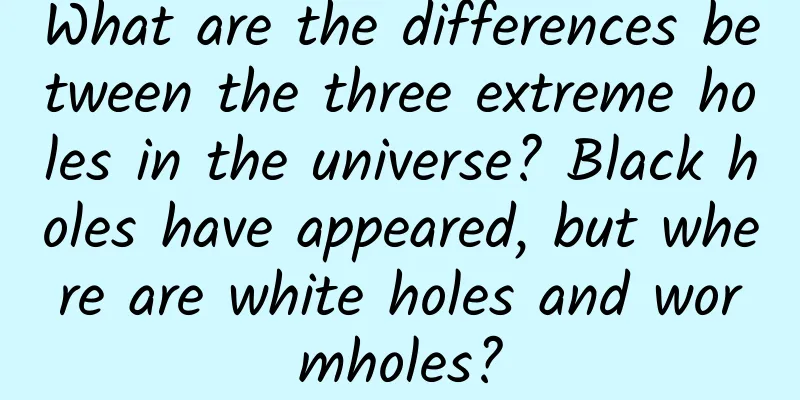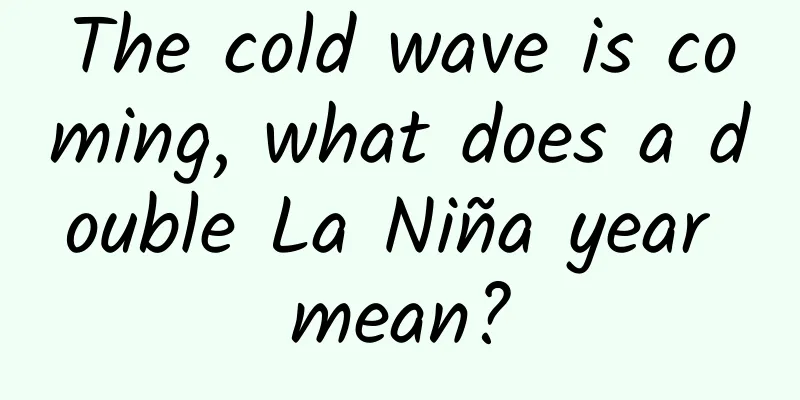What are the differences between the three extreme holes in the universe? Black holes have appeared, but where are white holes and wormholes?

|
Black holes, white holes, and wormholes are all special extreme existences in the universe. What they have in common is that they are all extreme results caused by gravity and obey Einstein's gravitational field equations (referred to as field equations). The formula is as follows: The derivation of this formula is very complicated, so I won't go into detail here. Although these three "holes" are all caused by the gravitational field, their properties are completely different. What they are and where they are hidden will be known after understanding these "holes" separately. Black hole To put it simply, a black hole is a strange phenomenon produced by the compression of matter to the limit. Theoretically, any matter can be compressed to the limit, from an atom to a planet, as long as the pressure is high enough, it can become a black hole. How high is this pressure? There is no specific value, but there is a formula to calculate the limit of matter compression. This formula is the Schwarzschild radius formula, expressed as: R=2GM/C^2. Here R represents the Schwarzschild radius, G is the gravitational constant, M is the mass of the object, and C is the speed of light. This formula was derived by astrophysicist Karl Schwarzschild in 1916 based on the gravitational field equations in Einstein's general theory of relativity, which had just been published. The meaning of this formula is that any matter that is compressed within the Schwarzschild radius of its own mass will undergo strange changes: all matter will inevitably fall onto the singularity at the core, and form a spherical space with the Schwarzschild radius as the boundary. This space has infinite curvature, and once any matter enters this space, it can no longer escape and can only fall onto the singularity in the center, even light is no exception. How big is this Schwarzschild radius? According to the formula, the mass of a hydrogen atom is about 1.674*10^-27kg (kilograms), and its Schwarzschild radius is about 2.48*10^-54m (meters); the mass of the earth is about 6*10^24kg, and its Schwarzschild radius is about 8.9mm (millimeters); the mass of the sun is about 2*10^30kg, and its Schwarzschild radius is about 2964m. Scientists believe that in the Large Hadron Collider, through the collision of particles at close to the speed of light, the huge pressure may create atomic-scale micro black holes. This idea is still only theoretical, and such tiny black holes have not yet been captured. In theory, many micro black holes will be left behind during the Big Bang. According to Hawking radiation theory, atomic-scale black holes will evaporate instantly, so such micro black holes have not been discovered so far. The smallest black hole discovered in the universe is more than three times the mass of the sun. These black holes are formed when massive stars die and thermonuclear runaway occurs inside them, triggering a supernova explosion. The extreme pressure compresses the core matter into the Schwarzschild radius of their own mass, thus becoming a black hole. It is generally believed that stars with a mass greater than 30 to 40 times that of the sun will directly leave behind a black hole when they die. The formation of black holes in the universe also involves the collision and accretion of massive celestial bodies, which collapse when their mass exceeds the critical point. For example, when a neutron star accretes and its mass exceeds the Oppenheimer limit, it will be compressed into a black hole. Theoretically, because the mass of a black hole is all at the singularity at the core, and that singularity is infinitely small, a black hole is understood to have an infinitely small volume, infinitely large density, infinitely large curvature, and infinitely high heat. The premise of these four infinities is that the volume is infinitely small, which leads to the appearance of the following three infinities. The curvature of a black hole is infinite, which means that within the Schwarzschild radius, its critical point is also called the black hole event horizon. The so-called curvature is the distortion of the surrounding space-time caused by mass, which manifests as gravity. At a great distance, its gravity still follows the law of universal gravitation, which is proportional to the mass and inversely proportional to the square of the distance, which is the same as the gravity of any celestial body. Since the gravitational force within the Schwarzschild radius of a black hole is infinite, any matter that approaches the black hole will be "eaten" and there is no return, so the black hole will become larger and larger. The largest black hole discovered in the universe is named SDSS J073739.96+384413.2, with a mass 104 billion times that of the sun. This is the past and present life of black holes. In the process of neutron stars turning into black holes, neutron stars are the celestial bodies with density second only to black holes discovered in the universe. They are medium to large mass stars, that is, stars with a mass of about 8 to 30 times that of the sun. After a supernova explosion in the late stage of evolution, the core part of the star has a dense core left behind. The radius of this core is only about 10km (kilometers), the density is as high as 100-200 million tons/cm^3 (cubic centimeters), and the surface pressure reaches 10^28 atmospheres, which is 330 trillion times greater than the terrain pressure and 330 trillion times greater than the pressure at the center of the sun. The mass of a neutron star is generally maintained at about 1.44 to 3 times the mass of the sun. According to the Pauli exclusion principle, a neutron star cannot become a neutron star if its mass is less than 1.44 times the mass of the sun, but can only become a white dwarf, with the electron degeneracy pressure supporting the star shape; while a neutron star relies on the neutron degeneracy pressure to support the gravity pressure and maintain the neutron star shape. When the mass exceeds the critical point, the neutron degeneracy pressure cannot support the gravity pressure, so the neutron star cannot maintain the star shape and quickly collapses into a quark star or a black hole. Due to the huge gravitational force of neutron stars, they will continuously accrete nearby celestial bodies or interstellar matter into themselves, continuously increasing their mass, so there is a high possibility that they will transform into a denser celestial body. Quark stars are still a theoretical hypothesis. Such celestial bodies have not yet been discovered. Therefore, it is generally believed that neutron stars will directly collapse into black holes when they exceed the Oppenheimer limit. The Oppenheimer limit is the critical mass point of neutron star exploration. This critical point has not yet been accurately determined. Through observation and theoretical calculation, the scientific community generally believes that it is between 2 and 3 times the mass of the sun. A black hole is the ultimate corpse of a star (or any celestial body). That is, any celestial body reaches its peak when it becomes a black hole. White hole is a theoretical conjecture that is exactly the opposite of a black hole. It is just a mathematical model assumed by physicists based on Einstein's field equations. So far, white holes have not been confirmed by observation. The basic definition of this model is that black holes constantly devour cosmic matter, while white holes do the opposite, constantly ejecting matter into the universe. Theoretically, black holes and white holes are both extreme celestial bodies in the universe. The gravitational force of a black hole is infinite, and the repulsive force of a white hole is infinite. They both have a closed boundary. Matter that enters the event horizon of a black hole is gone but never returns, and even light is no exception; while the event horizon of a white hole does not allow any matter to enter, it can only let matter out but not in, and even light is no exception. Because white holes are only a hypothetical celestial body that exists in theory, there are different theories about the cause of white holes. Among them, the more representative view is that at the beginning of the Big Bang, due to the insufficient and uneven explosion, some dense nuclei that did not have time to explode were ejected. These ejected dense nuclei are still in a singularity state, but the explosion is delayed, and some are delayed for more than 10 billion years before exploding. This kind of explosion is a white hole. The huge gravitational source at the core of a quasar is a white hole. The ejected matter collides with the surrounding matter, continuously emitting high-energy rays. In addition, there are several other viewpoints: First, white holes are the "inversion" of black holes, that is, when a black hole collapses to its limit, a qualitative change will occur, that is, an anti-collapse explosion, thereby transforming the energy accreting inward into energy erupting outward from the core; second, just as there are positive and negative matter in the universe, white holes and black holes are positive holes and negative holes in the universe, one releases energy and the other absorbs energy, with opposite properties. There is also a view that the matter absorbed by the black hole will be ejected from the white hole at the other end, and the pipe connecting the black hole and the white hole is a wormhole. The black hole and the white hole may be in the same space-time, but the two distant regions may also be in two different spaces with different properties. However, these theories are still controversial because no wormhole has been observed to exist. So do wormholes really exist? It's hard to say. The greatest pleasure of scientific discovery is that the predictions made by the theory are finally confirmed to exist. Black holes and gravitational lenses were discovered in this way. Will white holes be discovered or eventually denied? I don't know. Wormholes are also a prediction based on Einstein's field theory. The concept of "wormhole" was first proposed by Austrian physicist Ludwig Frame in 1916. Later, Einstein and Nathan Rosen perfected the theory, so people call wormholes "Einstein-Rosen bridges", also called space-time tunnels, which means multi-dimensional space tunnels connecting two distant time and space. This space-time connection is likely to connect to the "baby universe", that is, the period when galaxies and stars were just born shortly after the birth of the universe. This space-time is 13.8 billion light-years away from us, or even longer. In layman's terms, a wormhole is like a tunnel through a mountain by a highway or train. If there is no such tunnel, you need to climb over the top of the mountain or take many detours to get to the other side of the mountain, while going through a tunnel is much closer. Therefore, wormholes are considered to be "shortcuts" or "cuts" in the universe. With this shortcut, it is possible to achieve instantaneous transfer of distant time and space, such as quickly reaching the infant universe. The time required to reach the destination is many times faster than the speed of light if there is no shortcut. However, this "crossing" does not increase the speed, but only "takes a shortcut" and does not violate the principle of the speed limit of light. Therefore, wormhole crossing is a possible option for humans to break through the speed bottleneck, or break through the barrier of the speed of light. However, wormholes, like white holes, still only exist in the stage of scientific fantasy and theoretical conjecture, and have not been found to exist in reality. Whether they can be discovered or used in the future is still an unknown. There are many theories about the causes of wormholes. For example, as mentioned earlier, there is a material transport channel between black holes and white holes, which is the wormhole; there is also the collision of white holes and black holes, which will form a wormhole, etc. Generally speaking, a wormhole is a space-time vortex formed under the action of a huge gravitational field. The rotation of a massive celestial body and its interaction process will distort space-time, forming a space-time vortex or trap. This is a bit like a huge whirlpool in the sea, omnipresent but fleeting. Some whirlpools can bring two far-flung local areas very close in an instant. This kind of space-time vortex in the universe is called a "wormhole." Due to the uncertainty and fleeting nature of wormholes, even if they are found to exist, whether they can be used is controversial. Some people believe that only negative energy or dark matter can maintain the stability of wormholes. Negative energy and dark matter are still theoretical hypotheses at present, and people don’t know what these things are. Therefore, wormhole travel is still just science fiction or myth, and may always be a myth. Conclusion: From the above introduction, we can see that black holes, white holes, and wormholes are all "holes", but they are not ordinary holes. The only thing that can really be said to be a bit like a hole is the wormhole, and the other two are special celestial bodies. Fundamentally speaking, these three "holes" are phenomena or existences caused by the gravitational field, but they have completely different properties and their impacts and effects on the future of mankind are also different. At present, scientists have taken the first photo of a black hole through great efforts and at great cost, proving the existence of black holes. However, white holes and wormholes are still only in the theoretical stage, and it is still unclear whether they can be discovered in the future and whether they can be used by humans. Is this clear? If you have any questions, please leave a message in the comment area and discuss it together. Thanks for reading. The copyright of Space-Time Communication is original. Infringement and plagiarism are unethical behavior. Please understand and cooperate. |
<<: A day's plan begins in the morning. How should you eat breakfast?
>>: What will happen to the Qinghai-Tibet Plateau if global warming rises by 2°C?
Recommend
Two major channels for Tik Tok to get free traffic!
There is always not enough traffic for the video,...
How much does it cost to install a 400 phone? How much does it cost to install a 400 phone number?
After understanding how to apply for the 400 hotl...
A good way to make money online. How can you make money online at home?
Recently, a friend said to me, "I have to ta...
There are two ways of thinking for good operations
For a long time, we like to talk about product th...
Sweetener, no rotting, light taste? Five questions about Sunshine Rose grapes, all you care about is here →
When a person is famous, there are many controver...
What is the difference between WeChat, WhatsApp and LINE?
Wang Xing, the founder of Meituan, proposed a the...
Who is the leader of the aging world? Is there any creature that does not age?
Produced by: Science Popularization China Author:...
Why is the effect of information flow advertising worse after targeted advertising?
We all know that the first step in doing informat...
Hu Q&A: Are the oil drops in soup necessarily round?
Chili oil in hot pot and sesame oil in egg drop s...
Besides hot pot, what else can mushrooms be used for?
Produced by: Science Popularization China Author:...
How much does it cost for Atel to join a fast food mini program?
How much does it cost to join a fast food app in ...
After chatting with a group of marketing directors, some understandings about leading a team
After working for three to five years, most of my...
Analysis of Douyin advertising in Q2 2020
Based on the mobile advertising intelligence of D...
The shortcut from a novice to an expert in SEM bidding, you will regret it if you don’t read it!
The growth path of SEMer is a process of fighting...









